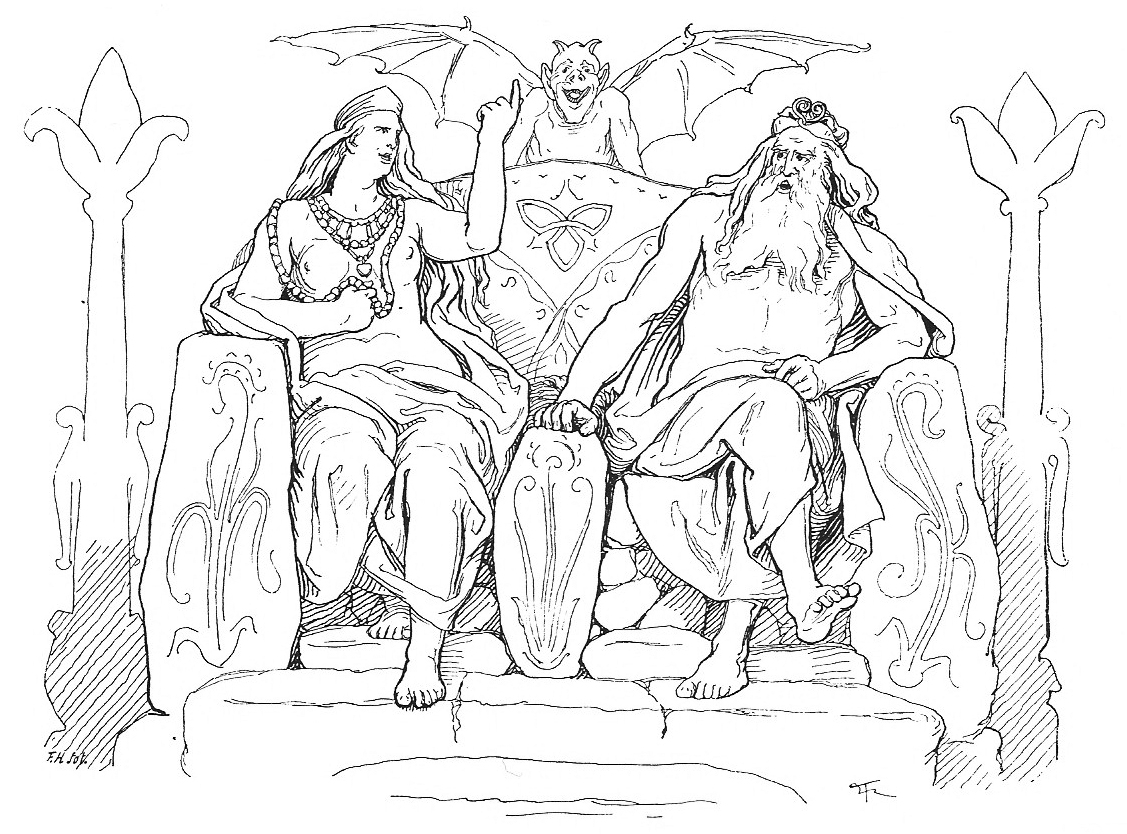|
Valaskjálf
In Norse mythology, Valaskjálf ("the Shelf of the Slain" translated by Henry Adams Bellows, p. 89) is one of Odin's Halls, a great dwelling built and roofed with pure silver. In this room is a high seat, , where Odin can watch over the entire universe. See also *Valhalla
In Norse mythology Valhalla (;) is the anglicised name for non, Valhǫll ("hall of the slain").Orchard (1997:171–172) It is described as a majestic hall located in Asgard and presided over by the god Odi ...
[...More Info...] [...Related Items...] OR: [Wikipedia] [Google] [Baidu] |
Hliðskjálf
In Norse mythology, Hliðskjálf is the high seat of the god Odin allowing him to see into all realms. ''Poetic Edda'' In ''Grímnismál'', Odin and Frigg are both sitting in Hliðskjálf when they see their foster sons Agnarr and Geirröðr, one living in a cave with a giantess and the other a king. Frigg then made the accusation to her husband that Geirröðr was miserly and inhospitable toward guests, so after wagering with one another over the veracity of the statement, Odin set out to visit Geirröðr in order to settle the matter. In ''Skírnismál'', Freyr sneaks into Hliðskjálf when he looks into Jötunheimr and sees the beautiful giant maiden Gerðr, with whom he instantly falls in love. ''Prose Edda'' In ''Gylfaginning'', Snorri mentions the high seat on four occasions. In the first instance he seems to refer to it rather as a dwelling place: "There is one abode called Hliðskjálf, and when Allfather sat in the high seat there, he looked out over the whole world ... [...More Info...] [...Related Items...] OR: [Wikipedia] [Google] [Baidu] |
Norse Mythology
Norse, Nordic, or Scandinavian mythology is the body of myths belonging to the North Germanic peoples, stemming from Old Norse religion and continuing after the Christianization of Scandinavia, and into the Nordic folklore of the modern period. The northernmost extension of Germanic mythology and stemming from Proto-Germanic folklore, Norse mythology consists of tales of various deities, beings, and heroes derived from numerous sources from both before and after the pagan period, including medieval manuscripts, archaeological representations, and folk tradition. The source texts mention numerous gods such as the thunder-god Thor, the raven-flanked god Odin, the goddess Freyja, and numerous other deities. Most of the surviving mythology centers on the plights of the gods and their interaction with several other beings, such as humanity and the jötnar, beings who may be friends, lovers, foes, or family members of the gods. The cosmos in Norse mythology consists of Nine Worl ... [...More Info...] [...Related Items...] OR: [Wikipedia] [Google] [Baidu] |
Odin
Odin (; from non, Óðinn, ) is a widely revered Æsir, god in Germanic paganism. Norse mythology, the source of most surviving information about him, associates him with wisdom, healing, death, royalty, the gallows, knowledge, war, battle, victory, sorcery, poetry, frenzy, and the Runes, runic alphabet, and depicts him as the husband of the goddess Frigg. In wider Germanic mythology and paganism, the god was also known in Old English as ', in Old Saxon as , in Old Dutch as ''Wuodan'', in Old Frisian as ''Wêda'', and in Old High German as , all ultimately stemming from the Proto-Germanic language, Proto-Germanic theonym *''Wōðanaz'', meaning 'lord of frenzy', or 'leader of the possessed'. Odin appears as a prominent god throughout the recorded history of Northern Europe, from the Roman occupation of regions of Germania (from BCE) through movement of peoples during the Migration Period (4th to 6th centuries CE) and the Viking Age (8th to 11th centuries CE). In the modern pe ... [...More Info...] [...Related Items...] OR: [Wikipedia] [Google] [Baidu] |
Valhalla
In Norse mythology Valhalla (;) is the anglicised name for non, Valhǫll ("hall of the slain").Orchard (1997:171–172) It is described as a majestic hall located in Asgard and presided over by the god Odin. Half of those who die in combat enter Valhalla, while the other half are chosen by the goddess Freyja to reside in Fólkvangr. The masses of those killed in combat (known as the Einherjar) along with various legendary Germanic heroes and kings, live in Valhalla until Ragnarök when they will march out of its many doors to fight in aid of Odin against the jötnar. Valhalla is attested in the '' Poetic Edda'', compiled in the 13th century from earlier traditional sources, in the ''Prose Edda'' (written in the 13th century by Snorri Sturluson), in '' Heimskringla'' (also written in the 13th century by Snorri Sturluson), and in stanzas of an anonymous 10th century poem commemorating the death of Eric Bloodaxe known as '' Eiríksmál'' as compiled in '' Fagrskinna''. Va ... [...More Info...] [...Related Items...] OR: [Wikipedia] [Google] [Baidu] |
Locations In Norse Mythology
In geography, location or place are used to denote a region (point, line, or area) on Earth's surface or elsewhere. The term ''location'' generally implies a higher degree of certainty than ''place'', the latter often indicating an entity with an ambiguous boundary, relying more on human or social attributes of place identity and sense of place than on geometry. Types Locality A locality, settlement, or populated place is likely to have a well-defined name but a boundary that is not well defined varies by context. London, for instance, has a legal boundary, but this is unlikely to completely match with general usage. An area within a town, such as Covent Garden in London, also almost always has some ambiguity as to its extent. In geography, location is considered to be more precise than "place". Relative location A relative location, or situation, is described as a displacement from another site. An example is "3 miles northwest of Seattle". Absolute location An absolute locatio ... [...More Info...] [...Related Items...] OR: [Wikipedia] [Google] [Baidu] |


